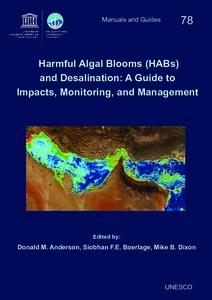| dc.description.abstract | Arid countries throughout the world are heavily reliant on seawater desalination for their
supply of drinking and municipal water. The desalination industry is large and rapidly
growing, approaching more than 20,000 plants operating or contracted in greater than 150
countries worldwide and capacity projected to grow at a rate of 12% per year for the next
several decades (http://www.desaldata.com; 2016). Desalination plants are broadly
distributed worldwide, with a large and growing capacity in what will be referred to as the
“Gulf” region throughout this manual. Here the Gulf refers to the shallow body of water
bounded in the southwest by the Arabian Peninsula and Iran to the northeast. The Gulf is
linked with the Arabian Sea by the Strait of Hormuz and the Gulf of Oman to the east and
extends to the Shatt al-Arab river delta at its western end.
One of the operational challenges facing the industry is also expanding globally – the
phenomena termed harmful algal blooms or HABs. Blooms are cell proliferations caused by
the growth and accumulation of individual algal species; they occur in virtually all bodies of
water. The algae, which can be either microscopic or macroscopic (e.g., seaweeds) are the
base of the marine food web, and produce roughly half of the oxygen we breathe. Most of the
thousands of species of algae are beneficial to humans and the environment, but there are a
small number (several hundred) that cause HABs. This number is vague because the harm
caused by HABs is diverse and affects many different sectors of society (see Chapter 1).
HABs are generally considered in two groups. One contains the species that produce potent
toxins (Chapter 2) that can cause a wide range of impacts to marine resources, including mass
mortalities of fish, shellfish, seabirds, marine mammals, and various other organisms, as well
as illness and death in humans and other consumers of fish or shellfish that have accumulated
the algal toxins during feeding. The second category is represented by species that produce
dense blooms - often termed high biomass blooms because of the large number of cells.
Cells can reach concentrations sufficient to make the water appear red (hence the common
term “red tide”), though brown, green and golden blooms are also observed, while many
blooms are not visible.
In this manual, we define toxic algae as those that produce potent toxins (poisonous
substances produced within living cells or organisms), e.g., saxitoxin. These can cause
illness or mortality in humans as well as marine life through either direct exposure to the
toxin or ingestion of bioaccumulated toxin in higher trophic levels e.g. shellfish. Nontoxic HABs can cause damage to ecosystems and commercial facilities such as desalination
plants, sometimes because of the biomass of the accumulated algae, and in other cases due to
the release of compounds that are not toxins (e.g., reactive oxygen species, mucilage) but that
can still be lethal to marine animals or cause disruptions of other types.
Both toxic and non-toxic HABs represent potential threats to seawater desalination facilities.
Although toxins are typically removed very well by reverse osmosis and thermal desalination
processes (see Chapter 10), algal toxins represent a potential health risk if they are present in
sufficiently high concentrations in the seawater and if they break through the desalination
process. It is therefore important for operators to be aware when toxic blooms are near their
plants so they can ensure that the removal has indeed occurred (Chapter 3). High biomass
blooms pose a different type of threat, as the resulting particulate and dissolved organic
material can accelerate clogging of media filters or contribute to (bio)fouling of pretreatment
and RO membranes which may lead to a loss of production.
Impacts of HABs on desalination facilities are thus a significant and growing problem, made
worse by the lack of knowledge of this phenomena among plant operators, managers,
6
engineers, and others involved in the industry, including regulatory agencies. Recognizing
this problem, the Middle East Desalination Research Center (MEDRC) and the UNESCO
Intergovernmental Oceanographic Commission (IOC) organized a conference in 2012 in
Muscat, Oman, to bring HAB researchers and desalination professionals together to exchange
knowledge and discuss the scale of the problem and strategies for addressing it. One of the
recommendations of that meeting was that a “guidance manual” be prepared to provide
information to desalination plant operators and others in the industry about HABs, their
impacts, and the strategies that could be used to mitigate those impacts. With support from
the US Agency for International Development (USAID) and the IOC Intergovernmental
Panel for Harmful Algal Blooms (IPHAB), an editorial team was assembled and potential
authors contacted. For the first time, HAB scientists worked closely with desalination
professionals to write chapters that were scientifically rigorous yet practical in nature – all
focused on HABs and desalination. During the planning of this manual, it became clear from
an informal survey of the desalination industry that generally, HAB problems are far more
significant for seawater reverse osmosis (SWRO) plants than for those that use thermal
desalination. Both types of processes are very effective in removing HAB toxins (Chapter 10),
but the SWRO plants are far more susceptible to clogging of pretreatment granular media
filters and fouling of membranes by algal organic matter and particulate biomass.
Accordingly, the focus of this book is on SWRO, with only occasional reference to thermal
processes. Likewise, emphasis has been placed on seawater HABs, with reference to
estuarine and brackish-water HABs only when practices from those types of waters can be
informative or illustrative.
A brief synopsis of the book follows. Chapter 1 provides a broad overview of HAB
phenomena, including their impacts, the spatial and temporal nature of their blooms, common
causative species, trends in occurrence, and general aspects of bloom dynamics in coastal
waters. Chapter 2 describes the metabolites of HAB cells, including toxins, taste and odor
compounds. Methods for analyses are presented there, supplemented by detailed
methodological descriptions of rapid toxin screening methods in Appendix 2. As discussed in
Chapters 8 and 10, thermal and SWRO operations are highly effective in the removal of HAB
toxins, but plant personnel should have the capability to screen for these toxins in raw and
treated water to ensure that this removal has been effective. This would be critical, for
example, if the public or the press were aware of a toxic HAB in the vicinity of a desalination
plant intake and asked for proof that their drinking water is safe.
Currently, most desalination plants do not collect data on seawater outside their plants, so
they are generally unaware of the presence (now or anticipated) of a potentially disruptive
HAB. Chapter 3 provides practical information on the approaches to implementing an
observing system for HABs, describing sampling methods and measurement options that can
be tailored to available resources and the nature of the HAB threat in a given area. Appendix
4 provides more details on methods used to count and identify HAB cells during this process.
All are based on direct water sampling, but it is also possible to observe HABs from space –
particularly the high biomass events. Chapter 4 describes how satellite remote sensing can be
used to detect booms. The common sources of imagery (free over the Internet) are presented,
as well as descriptions of the software (also free) that can be used to analyze the satellite data.
It is relatively easy and highly informative for plant personnel to use this approach to better
understand what is in the seawater outside their plants. The cover of this guide provides a
graphic example of the incredible scale and resolution of this observational approach.
Chapter 5 discusses typical water quality parameters that are measured online or in feedwater
samples at desalination plants that could be used to detect blooms at the intake or evaluate
process efficiency in removing algal particulates and organics. Emerging parameters that also
7
show promise are examined to provide a resource for plant personnel. Chapter 6 looks at
desalination seawater intakes that are the first point of control in minimizing the ingress of
algae into the plant. A brief overview of siting considerations that may ultimately drive the
location of an intake is also provided.
One question asked frequently of HAB scientists is whether the blooms can be controlled or
suppressed in a manner analogous to the treatment of insects or other agricultural pests on
land. This has proven to be an exceedingly difficult challenge for the HAB scientific and
management community, given the dynamic nature of HABs in coastal waters, their large
spatial extent, and concerns about the environmental impacts of bloom control methods.
Chapter 7 presents a summary of the approaches to bloom prevention and control that have
been developed, and discusses whether these are feasible or realistic in the context of an
individual desalination plant.
Chapter 8 describes management strategies for HABs and risk assessment, including Hazard
Analysis Critical Control Point (HACCP) and Alert Level Framework procedures. Once a
HAB is detected, a wide range of approaches can be used to address the problems posed by
the dissolved toxins associated with those blooms. Chapter 9 presents many of these
pretreatment strategies and discusses their use in removing algal organic matter and
particulates to prevent filter clogging and membrane fouling. This is necessary to maintain
effective plant operation and avoid serious operational challenges for the reverse osmosis
step. The chapter covers common pretreatments such as chlorination/dechlorination,
coagulation, dissolved air flotation, granular media filtration, ultrafiltration, and cartridge
filtration, in addition to discussing issues experienced due to the inefficiencies of each
pretreatment on reverse osmosis.
Chapter 10 then addresses the important issue of HAB toxin removal during pretreatment and
desalination, and describes laboratory and pilot-scale studies that address that issue. Finally,
Chapter 11 provides a series of case studies describing individual HAB events at desalination
plants throughout the world, detailing the types of impacts and the strategies that were used
to combat them. These studies should be of great interest to other operators as they encounter
similar challenges.
The manual concludes with a series of appendices that provide images and short descriptions
of common HAB species (Appendix 1), rapid screening methods for HAB toxins (Appendix
2), methods to measure transparent exopolymer particles (TEP) and their precursors
(Appendix 3), methods to enumerate algal cells (Appendix 4), and reverse osmosis autopsy
and cleaning methods (Appendix 5).
Compilation of this manual was a major undertaking, requiring the cooperation of scientists
and engineers from multiple disciplines, including a number where interactions have been
rare in the past. We hope the accumulated material proves useful, and plan to keep this
document updated through time and readily available through the Internet. The Editors
welcome questions, comments, and suggestions that can make this compilation more useful
and accurate. | en_US |
 Repository of community practices in Ocean Research, Applications and Data/Information Management
Repository of community practices in Ocean Research, Applications and Data/Information Management
